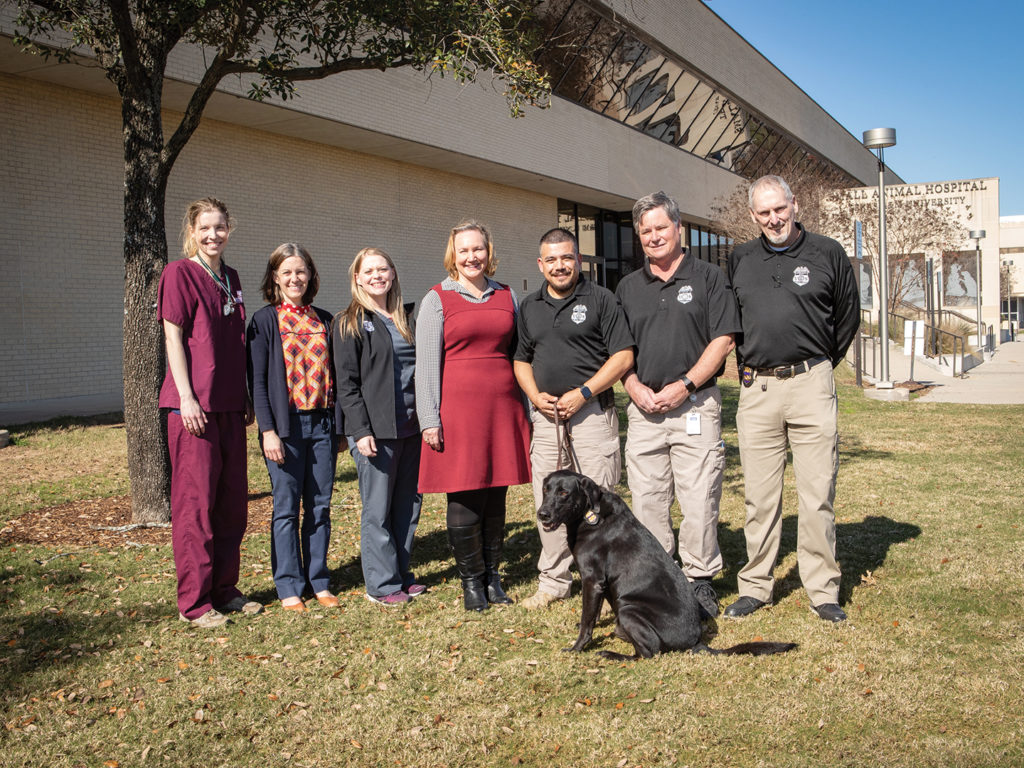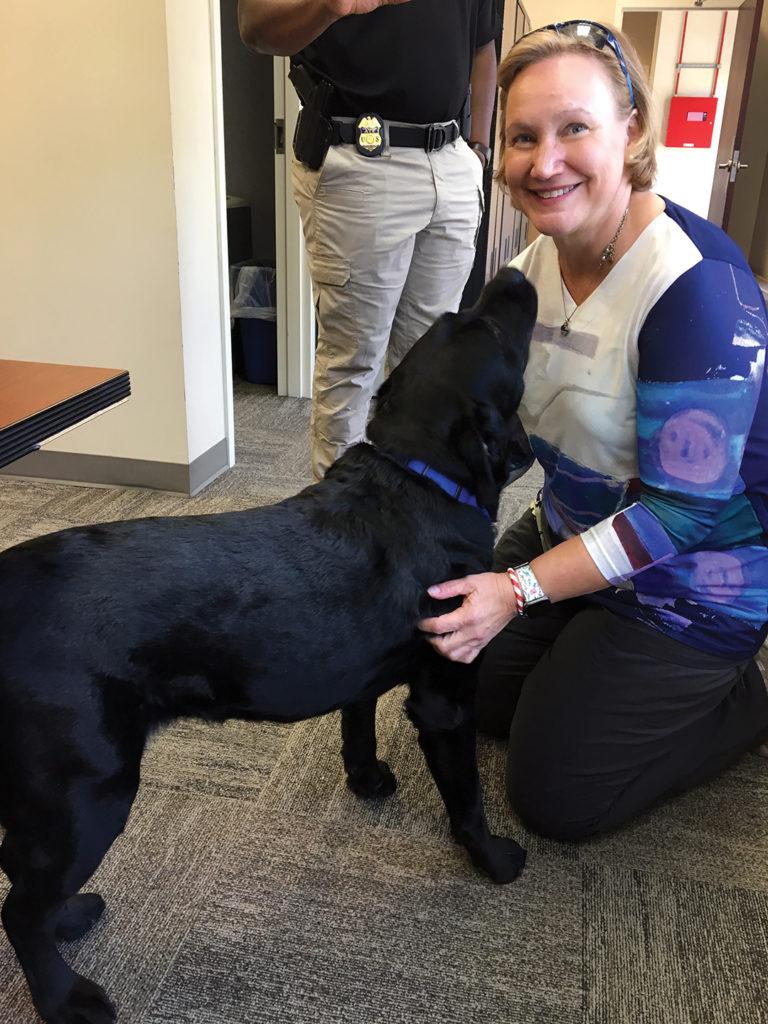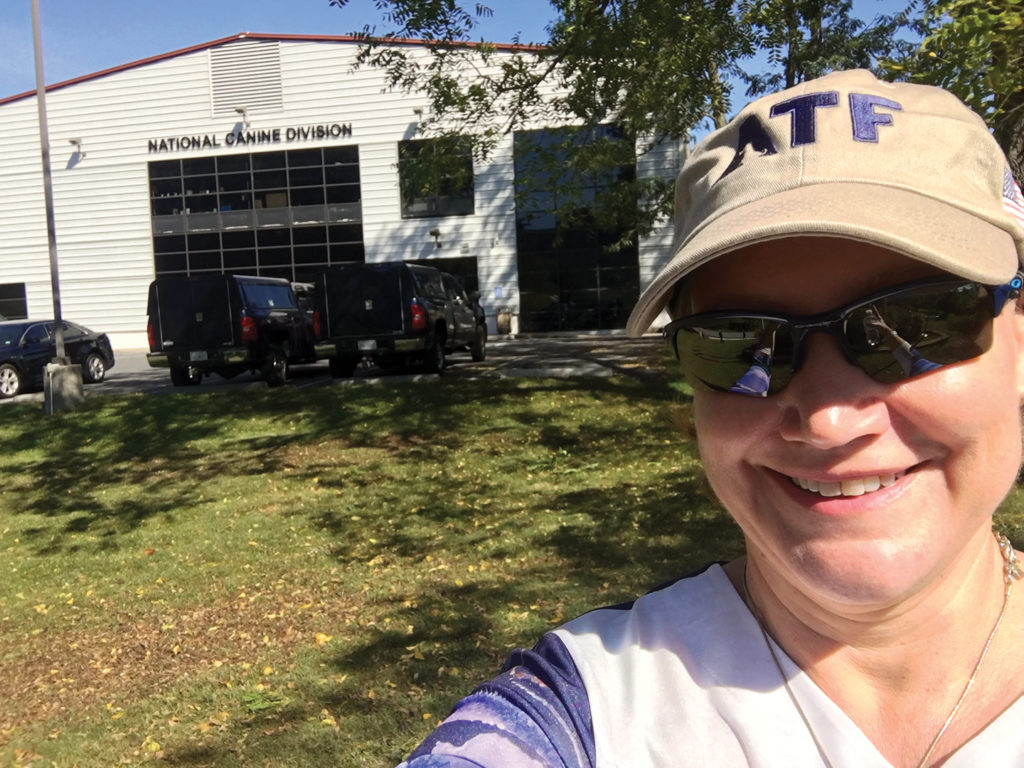Texas A&M Alumna Creates VMTH Fund To Support K-9 Heroes
Story by Jennifer Gauntt, CVMBS Communications

Almost everybody has a cancer story—a story about how the disease has affected their life or the life of somebody they love.
For Stacy LeBlanc, cancer played a part in one of the earliest losses of her life; she was just 12 years old when her 47-year-old mother died of cancer.
But this isn’t a sad story; instead, it is a story of how, as fate would have it, the many challenges LeBlanc faced brought her to a place where she could combine a love for animals and medicine in unexpected ways and with unexpected results.
That journey ultimately led her to a career at The University of Texas MD Anderson Cancer Center in Houston, where, as operations manager and later department administrator in the Department of Veterinary Medicine and Surgery, she participated in the design of a state-of-the-art research animal facility and oversees 159 staff, all in support of laboratory animal care.
LeBlanc’s connection to cancer would also bring her to the Texas A&M College of Veterinary Medicine & Biomedical Sciences’ (CVMBS) Veterinary Medical Teaching Hospital (VMTH), where a chance encounter would lead to the establishment of a fund that now supports K-9 heroes as they battle illnesses like the ones her team at MD Anderson works every day to develop treatments for.
Turning Disappointments Into Opportunities
LeBlanc often returns to Texas A&M to talk to pre-veterinary students about having a “plan B” for their lives, in part because the idea of a “plan B” wasn’t something she had ever considered for herself as an Aggie undergraduate.
LeBlanc had been laser-focused on a career as a veterinarian since her childhood, and to achieve that goal, she “did it all”—she worked as a veterinary technician at a local clinic; earned her bachelor’s degree in biomedical sciences and her master’s degree in veterinary medical sciences, with a focus on animal behavior; gained experience in small, large, and exotic animal medicine; worked with research animals in the labs of Dr. Bonnie Beaver and Dr. Don Hulse; managed the Brazos County Animal Shelter on the weekends; and even served as the assistant dog catcher in Navasota.
“I knew what I was getting into. I knew what I wanted to do,” she said. “And then, I didn’t get into vet school.

“I only ever had plan A. I could have gone to vet school somewhere else, but A&M is the only place I wanted to be,” she said. “I tried three times and then decided against a fourth. I got interviews every time. But my prerequisite grades weren’t good enough.”
Heartbroken, LeBlanc found herself back at the same veterinary clinic she had worked at since she was a high school sophomore.
But a chance encounter led her to a prayer breakfast, during which a veterinarian from MD Anderson spoke about working with animals for cancer research and introduced her to a new career field—laboratory animal medicine.
She initially turned down a job offer at MD Anderson but, later realizing her mistake, applied for and accepted a veterinary technician position at Baylor College of Medicine.
Her path from there took her on an upward trajectory through the field—from healthcare into animal husbandry and welfare—before an operations manager position allowed her to join MD Anderson, working for Dr. Kenneth Gray, the veterinarian from that prayer breakfast and a CVMBS Outstanding Alumnus.
Much like her veterinary experience, LeBlanc’s 26 years with MD Anderson have included a variety of opportunities, from operations to facility construction and design, facility maintenance and security, and department administration.
It’s been a fun, exciting, and fulfilling career, one that sometimes leaves LeBlanc in awe of all she’s been able to accomplish.
“I thank God every day that I had to go to plan B because I have had the most spectacular career I could ever dream of,” she said. “If somebody would have said 32 years ago that I would design an animal facility for the No. 1 cancer center in the world, I’d say you’re out of your mind. Construction? No! But I did that. I’d never have had that in private practice.”
Helping K-9 Heroes
In addition to the fortuitous encounter that led her into laboratory animal medicine, LeBlanc has had several other serendipitous encounters that have allowed her passions to converge.
In September 2019, she accompanied her friend Leticia McGuffey to the Texas A&M Small Animal Hospital, where McGuffey’s dog had been treated for cancer. While in the lobby, LeBlanc overheard McGuffey talking with development officer Monika Blackwell.
“I got drawn into their conversation, and we eventually started talking about A&M’s police department getting a K-9 a few years ago,” LeBlanc said. “I asked Monika if there were any mechanisms to donate to help cover costs of their care. At that time, there weren’t, but Monika worked with me to set up the Help For K-9 Heroes Fund.”

The Help for K-9 Heroes Endowment now supports the veterinary care of dogs from the law enforcement community—including police dogs, explosive-detection K-9s, and search-and-rescue dogs—that come through the SAH’s emergency service or any of the hospital’s specialty services.
LeBlanc’s affinity for working dogs was strengthened as part of her participation in the Bureau of Alcohol, Tobacco, Firearms, and Explosives (ATF) Citizens Academy, during which she toured the National Canine Training Center, where accelerant and explosives detection dogs are trained.
“I’ve always been a huge supporter of law enforcement. I have law enforcement in my family. But going through the citizens academies—I’ve done several now—when I saw these dogs and experienced canine work, I saw a whole different side of law enforcement that just really blew me away,” she said.
Because of her experiences, both through the academies and as a manager, she understands that even the most well-funded agencies have a finite amount of resources, so she sees her fund as a way to give back.
“In some small agencies, the canine program might not be funded at a level that could handle sending a dog to Texas A&M for any kind of specialty treatment,” LeBlanc said. “With this fund, if a small agency is trying to decide whether to retire a dog who otherwise could have more years of service and quality of life, this can help them make that decision to send the dog here and get the help it needs.
“I know it sounds cliché, but they do so much for us; this is a way of doing something for them,” she said.
Cancer And Canines
Throughout LeBlanc’s career at MD Anderson, she’s witnessed medical advances that have fundamentally changed how we look at cancer.
“When my mom died of breast cancer in 1976, cancer was a death sentence. If she were diagnosed today, she’d be a survivor,” she said. “My whole career has been dedicated to the care and welfare of laboratory animals in an effort to safely advance health care. Some of those treatments I’ve had a hand in developing, even remotely, have kept kids from losing their parents to cancers that used to be killers and also have saved dogs’ lives.
“When I was a young vet tech, I worked with researchers who were developing these things called stents, and nobody had ever heard of them. Now, practically everybody over 50 has one or two,” she continued. “So, I feel like what I do matters; it’s so gratifying.”
Likewise, LeBlanc knows that through her Help for K-9 Heroes Fund, she will impact untold numbers of dogs who will benefit from both the research conducted at MD Anderson and the care they’ll receive at the SAH.
“Because the fund is for specialized care and emergencies, I pray no dog would ever need it. But that someone is able to benefit from my gift,” she says, her voice breaking as she tears up, “and that I’m able to help somebody in some small way is very exciting. I’m just over the moon about that.”
The Help for K-9 Heroes Veterinary Valor Fund accepts donations online from other donors. For more information, please contact Larry Walker, Senior Director of Development for the College of Veterinary Medicine & Biomedical Sciences, at lwalker@txamfoundation.com or by phone at 979.845.9043. Give online at give.am/K-9HeroesEndowment.
###
Note: This story originally appeared in the Spring 2021 edition of CVMBS Today.
For more information about the Texas A&M College of Veterinary Medicine & Biomedical Sciences, please visit our website at vetmed.tamu.edu or join us on Facebook, Instagram, and Twitter.
Contact Information: Jennifer Gauntt, Director of CVMBS Communications, Texas A&M College of Veterinary Medicine & Biomedical Sciences; jgauntt@cvm.tamu.edu; 979-862-4216


